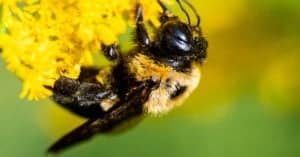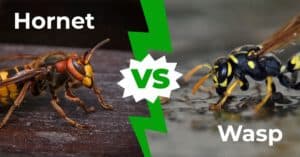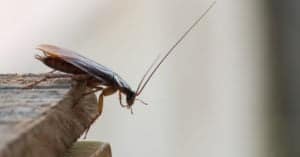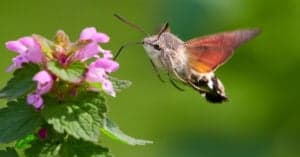What Do Leeches Eat?
Leeches are well known, feared, and despised throughout much of the world. With nearly 700 species of leech living on six continents (Antarctica being the exception), it’s no wonder they’re so famous. Leeches are common in just about any source of fresh, shallow, still water, and they frequently come into contact with humans.
Here, we’ll learn about what different species of leech eat, why they’re feared, and what to do if a leech bites you. Then, we’ll explore exactly why leeches eat what they eat, and why doctors still use them for medical benefit.
The Leech Diet

photowind/Shutterstock.com
Leeches are either predatory and eat invertebrates, small slugs, and earthworms; or they are parasitic and suck blood. They are predominantly carnivores.
Leeches are annelids (segmented worms). About 75% of leech species are sanguivores and survive by eating blood only. They are not picky about what creatures they suck blood from; a few of the most common hosts are:
- Fish
- Freshwater Turtles
- Small mammals
- Amphibians: toads, frogs, newts, salamanders
- Ducks
- Larger animals that enter the water, like humans and livestock
Not all leeches live exclusively on blood, about 25% of species are ambush predators, and actually hunt and kill their prey. These species’ of leech eat tiny invertebrates, snails, slugs, and earthworms.
Most leeches are 3-4 inches in length, and stretch out their bodies to move, like earthworms. Some species of leech, however, are much larger. The Amazonian giant leech can reach over 16 inches in length, getting even longer when it stretches. Fortunately for us, this leech poses no danger to humans, and eats blood from unaware hosts just like its smaller counterparts.
How Do Leeches Hunt?
Most leeches are aquatic and spend their lives hiding in still, dark water, waiting for something to attract their attention. With their tubular, flattened bodies they are good swimmers, and can detect movement in the water.
Once the parasitic leech detects something moving, it swims towards it and, and uses one of its suckers (it has one on each end of its body) to latch onto the host. Then, using tiny, sharp teeth, it cuts a ‘y’ shaped hole and releases hirudin, an anticoagulant, into the wound. The hirudin prevents the blood from clotting, allowing the leech to digest it. From there, the leech simply hangs on until it’s full, then it drops off. Oftentimes the host is none the wiser and walks (or swims) away virtually unharmed.
Predatory leeches do not drink blood, but rather eat their tiniest prey whole. For larger insects, like slugs and earthworms, predatory leeches actually feed on the prey’s soft tissue. They eat using a proboscis, which is similar to a tongue. The proboscis protrudes from the sucker, and with invertebrates, sucks them in whole. With larger insects, the proboscis plunges into the creature to get to the soft tissue.
A small number of leech species are terrestrial, meaning they live on land. These leeches will often wait on the ground, hidden in leafy debris, with their heads in the air. When a host, like a small mammal or a deer, passes by, they latch on and begin sucking the host’s blood.
Are Leeches Dangerous?
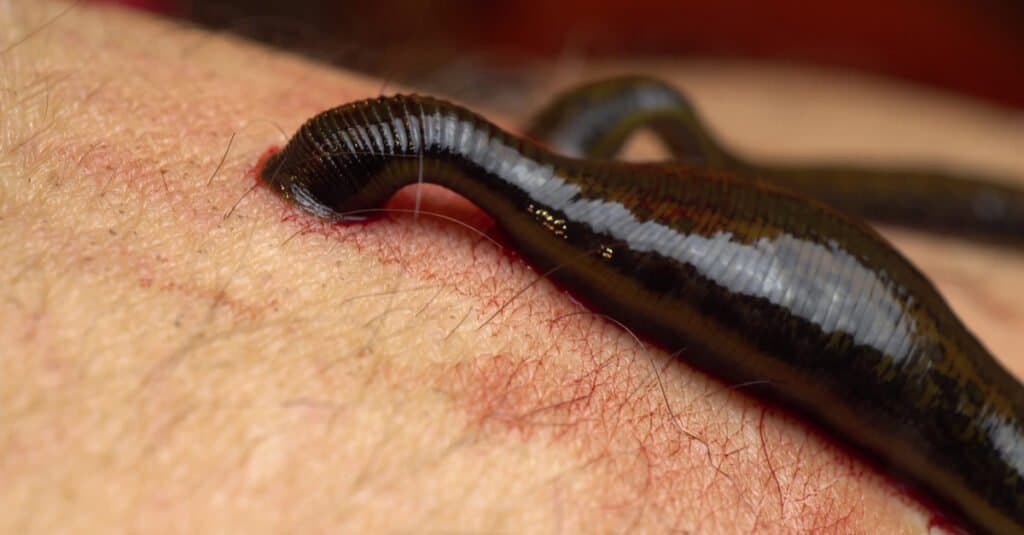
Vital9s/Shutterstock.com
Although scary to many, leeches are not dangerous to humans. Many people, particularly those who’ve gone swimming in ponds or lakes in the northern hemisphere, are very familiar with leeches. Leeches can become extremely abundant in the appropriate settings (up to 1,000 per square foot).
When a leech latches onto a human, it’s important to remember not to rip it off by hand, as this may rip the leech’s mouth parts off, leaving them embedded in the host’s flesh. Rather, leeches should be removed using either salt (sprinkled on the leech) or heat (as from a hair dryer). Once removed, the wound should be cleaned, disinfected, and bandaged.
In general, leeches are not dangerous to animals. They can however become attached to the mucous membranes inside the nostrils of livestock and cause breathing difficulties. In very rare cases they can cause death through suffocation this way.
Why Do Leeches Eat Blood?
Parasitic leeches are hematophagous, meaning blood-eating. Just like creatures that have developed to derive their nutrients from plants or animals, leeches have evolved to live off of blood. They are highly successful parasitic worms because of this specialization.
Blood sucking may disgust many, but leeches don’t suck blood because they’re evil or disgusting; they do it to live. And, in most cases, they don’t do any harm to the host creature in the process. A blood filled leech will simply fall off the host, likely not feeding again for months. In fact, leeches are so harmless that they’ve been used in human medicine for hundreds of years.
Medical Leeches
Leeches were commonly used in medicine well into the 19th century because of their blood sucking abilities. Most leeches eat blood, and before modern medicine, it was believed that sickness or ill health were largely caused by bad blood. Thus, when medical practitioners needed to ‘bleed’ a patient, they usually turned to the trusty leech.
Because leeches release hirudin, an anticoagulant, they made the perfect tool for bleeding patients. When leeches eat all the blood they want, they release from the host, but the hirudin keeps working. Medical practitioners could easily control how much they bled the patient by how many leeches they attached to the skin.
Today, leeches are still used in the treatment of various diseases and as an after surgery care aid. Leeches are frequently used to prevent the buildup of excess blood, or to increase blood flow to specific areas. These leeches are specially bred and known as ‘medical’ leeches; they are fully sanitized and clean when they are attached to their human hosts. Even today, leeches play an important part in medical science and patient care.
More from A-Z Animals
Leeches are well known, feared, and despised throughout much of the world. With nearly 700 species of leech living on six continents (Antarctica being the exception), it’s no wonder they’re so famous. Leeches are common in just about any source of fresh, shallow, still water, and they frequently come into contact with humans.
Here, we’ll learn about what different species of leech eat, why they’re feared, and what to do if a leech bites you. Then, we’ll explore exactly why leeches eat what they eat, and why doctors still use them for medical benefit.
The Leech Diet

photowind/Shutterstock.com
Leeches are either predatory and eat invertebrates, small slugs, and earthworms; or they are parasitic and suck blood. They are predominantly carnivores.
Leeches are annelids (segmented worms). About 75% of leech species are sanguivores and survive by eating blood only. They are not picky about what creatures they suck blood from; a few of the most common hosts are:
- Fish
- Freshwater Turtles
- Small mammals
- Amphibians: toads, frogs, newts, salamanders
- Ducks
- Larger animals that enter the water, like humans and livestock
Not all leeches live exclusively on blood, about 25% of species are ambush predators, and actually hunt and kill their prey. These species’ of leech eat tiny invertebrates, snails, slugs, and earthworms.
Most leeches are 3-4 inches in length, and stretch out their bodies to move, like earthworms. Some species of leech, however, are much larger. The Amazonian giant leech can reach over 16 inches in length, getting even longer when it stretches. Fortunately for us, this leech poses no danger to humans, and eats blood from unaware hosts just like its smaller counterparts.
How Do Leeches Hunt?
Most leeches are aquatic and spend their lives hiding in still, dark water, waiting for something to attract their attention. With their tubular, flattened bodies they are good swimmers, and can detect movement in the water.
Once the parasitic leech detects something moving, it swims towards it and, and uses one of its suckers (it has one on each end of its body) to latch onto the host. Then, using tiny, sharp teeth, it cuts a ‘y’ shaped hole and releases hirudin, an anticoagulant, into the wound. The hirudin prevents the blood from clotting, allowing the leech to digest it. From there, the leech simply hangs on until it’s full, then it drops off. Oftentimes the host is none the wiser and walks (or swims) away virtually unharmed.
Predatory leeches do not drink blood, but rather eat their tiniest prey whole. For larger insects, like slugs and earthworms, predatory leeches actually feed on the prey’s soft tissue. They eat using a proboscis, which is similar to a tongue. The proboscis protrudes from the sucker, and with invertebrates, sucks them in whole. With larger insects, the proboscis plunges into the creature to get to the soft tissue.
A small number of leech species are terrestrial, meaning they live on land. These leeches will often wait on the ground, hidden in leafy debris, with their heads in the air. When a host, like a small mammal or a deer, passes by, they latch on and begin sucking the host’s blood.
Are Leeches Dangerous?

Vital9s/Shutterstock.com
Although scary to many, leeches are not dangerous to humans. Many people, particularly those who’ve gone swimming in ponds or lakes in the northern hemisphere, are very familiar with leeches. Leeches can become extremely abundant in the appropriate settings (up to 1,000 per square foot).
When a leech latches onto a human, it’s important to remember not to rip it off by hand, as this may rip the leech’s mouth parts off, leaving them embedded in the host’s flesh. Rather, leeches should be removed using either salt (sprinkled on the leech) or heat (as from a hair dryer). Once removed, the wound should be cleaned, disinfected, and bandaged.
In general, leeches are not dangerous to animals. They can however become attached to the mucous membranes inside the nostrils of livestock and cause breathing difficulties. In very rare cases they can cause death through suffocation this way.
Why Do Leeches Eat Blood?
Parasitic leeches are hematophagous, meaning blood-eating. Just like creatures that have developed to derive their nutrients from plants or animals, leeches have evolved to live off of blood. They are highly successful parasitic worms because of this specialization.
Blood sucking may disgust many, but leeches don’t suck blood because they’re evil or disgusting; they do it to live. And, in most cases, they don’t do any harm to the host creature in the process. A blood filled leech will simply fall off the host, likely not feeding again for months. In fact, leeches are so harmless that they’ve been used in human medicine for hundreds of years.
Medical Leeches
Leeches were commonly used in medicine well into the 19th century because of their blood sucking abilities. Most leeches eat blood, and before modern medicine, it was believed that sickness or ill health were largely caused by bad blood. Thus, when medical practitioners needed to ‘bleed’ a patient, they usually turned to the trusty leech.
Because leeches release hirudin, an anticoagulant, they made the perfect tool for bleeding patients. When leeches eat all the blood they want, they release from the host, but the hirudin keeps working. Medical practitioners could easily control how much they bled the patient by how many leeches they attached to the skin.
Today, leeches are still used in the treatment of various diseases and as an after surgery care aid. Leeches are frequently used to prevent the buildup of excess blood, or to increase blood flow to specific areas. These leeches are specially bred and known as ‘medical’ leeches; they are fully sanitized and clean when they are attached to their human hosts. Even today, leeches play an important part in medical science and patient care.

